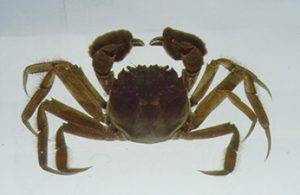Background | Planned Response | How to Identify a Mitten Crab | What to do if you Find a Mitten Crab | New York Distribution Map

Background
The first Chinese mitten crab documented in Chesapeake Bay was collected June 9, 2006 at the mouth of the Patapsco River, Maryland by a commercial waterman fishing crab pots. This was the first confirmed report of a Chinese mitten crab (Eriocheir sinensis) in the Eastern United States. The species is native to East Asia, and is a potential invasive that could have negative ecological impacts. The Chinese mitten crab occurs in both freshwater and saltwater. It is catadromous, migrating from freshwater rivers and tributaries to reproduce in salt water. Young crabs spend 2-5 years in freshwater tributaries and can extend over 50 miles inland, potentially above fall lines. Mature male and female crabs migrate downstream to mate and spawn in salt water estuaries.
Under the Federal Lacey Act, importation and interstate transport of this animal is prohibited.
On June 23, 2007 a mature female mitten crab was captured in a commercial crab pot off Kent Point in the Maryland portion of Chesapeake Bay. This was the fourth mitten crab captured in the Bay in 3 years, and the first mature female. As of that date, no mitten crabs had been confirmed in upstream, freshwater habitats where they spend the bulk of their lives, burrowing in tributary banks. In late May 2007, four mature male mitten crabs were captured in commercial crab pots in Delaware Bay, and one mature male was reported from a commercial crab pot in the Hudson River, New York. There are several possible transfer mechanisms that could result in the delivery of these crabs to local waters, without the species becoming established. However, due to the documented ability of this species to invade and to establish itself in new areas, Maryland Department of Natural Resources (MD DNR), the Smithsonian Environmental Research Center (SERC), the US Fish and Wildlife Service (USFWS), and the National Oceanic and Atmospheric Administration (NOAA) established a joint effort to investigate the status of this species.
Planned Response
MD DNR and partner agencies are taking these encounters seriously. This watch statement has been circulated to federal, state, county, municipal and private agencies and/or organizations that are conducting sampling programs in the Chesapeake Bay watershed and potential mitten crab habitat. MD DNR is also networking with commercial watermen, fish passage monitoring programs, and with power companies that monitor species captured on cooling water intake screens. This broad based monitoring is the first step to assessing if additional mitten crabs are present in the Bay habitat.
How to Identify a Mitten Crab

Correctly Identifying Mitten CrabsThere is another species of crab found in Maryland, which has been mistakenly identified as a Mitten Crab.
What to do if you Find a Mitten Crab
Never transport a live Mitten crab except to deliver to proper authorities. Mitten crab specimens are needed to confirm sightings, so please follow the instructions above, if you find a mitten crab. To learn more about mitten crabs see: With special thanks to our partners, USFW, NOAA, and SERC. New York Distribution MapThis map shows confirmed observations (green points) submitted to the NYS Invasive Species Database. Absence of data does not necessarily mean absence of the species at that site, but that it has not been reported there. For more information, please visit iMapInvasives. |
||||



